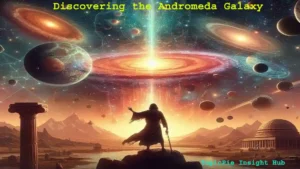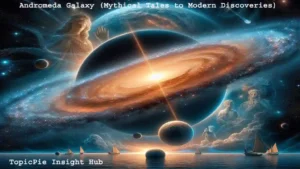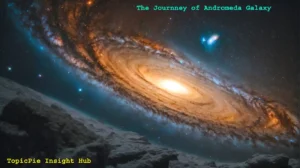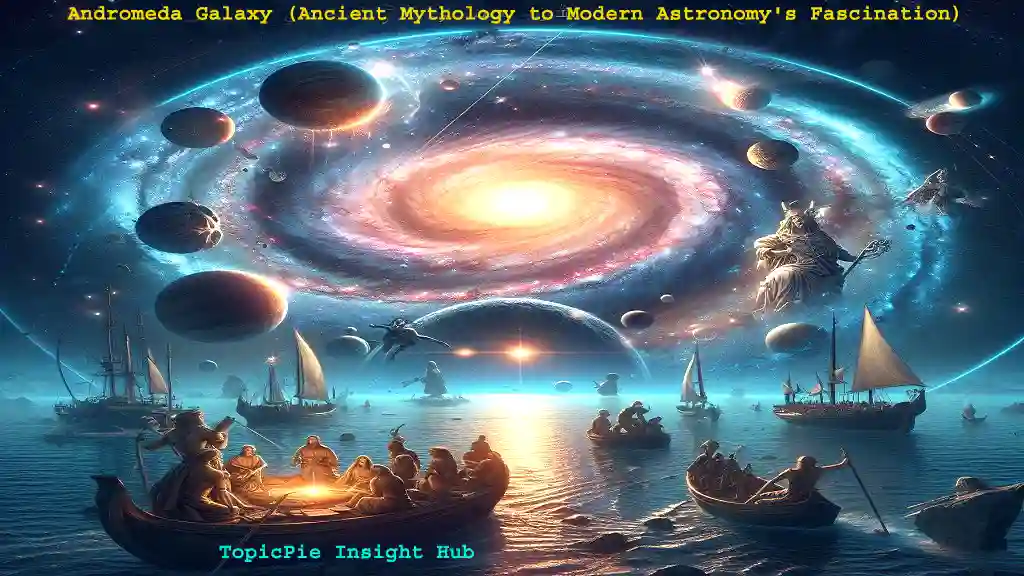Step into the vast expanse of the universe, where ancient myths intertwine with modern scientific discoveries. Today, we embark on a captivating journey through time and space to unravel the mesmerizing history of the Andromeda Galaxy. Brace yourself for tales of celestial beings, cosmic collisions, and profound implications for our very existence. Get ready to be amazed by this stellar wonder that has captivated astronomers and storytellers alike throughout the ages. So, fasten your seatbelts and let’s dive headfirst into this galactic odyssey!
Mythical Tales: Andromeda Galaxy in Ancient Cosmos Narratives:
Long before telescopes and scientific observations, the night sky was a canvas upon which ancient civilizations painted their myths and legends. Andromeda, the beautiful princess of Ethiopia, became a prominent figure in Greek mythology. According to the tale, her mother Cassiopeia boasted that she was more beautiful than the sea nymphs known as Nereids. This angered Poseidon, who sent Cetus, a monstrous sea creature, to ravage their land.
To appease Poseidon’s wrath, Andromeda was chained to a rock by her parents as an offering for Cetus. However, just as all hope seemed lost for Andromeda’s fate, Perseus arrived on his winged horse Pegasus and rescued her from certain doom.
And so it goes that in the vast expanse of space we now refer to this constellation as “Andromeda,” forever immortalizing her story amidst the stars above us. The ancients saw these celestial formations as connections between humanity and the divine – tales passed down through generations like whispers in time.
In different cultures around the world, variations of this myth emerged with each civilization adding its own unique twist. From Persia to China to Arabia – all had their interpretations of this ethereal beauty adorning our night skies.
These ancient stories not only provided entertainment but also served practical purposes such as navigation or understanding seasonal changes. They were ways for people to make sense of their surroundings while instilling wonder and awe at what lay beyond our earthly realm.
Today we look up into those same starry nights with eyes filled with curiosity rather than fearful superstition. Science and observation unravel distant galaxies’ mysteries. Yet, cosmic wonders shape our collective imagination, connecting us to ancestral dreams. Night sky’s beauty extends beyond scientific understanding. It weaves a timeless tapestry, reminding us of ancestors’ dreams and marvels.
Discovering the Andromeda Galaxy:

In a vast universe filled with billions of galaxies, one celestial beauty stands out among the rest – the Andromeda Galaxy. Its discovery was an awe-inspiring moment that opened up new realms of understanding about our place in the cosmos.
The credit for discovering this magnificent galaxy goes to none other than Simon Marius and Johannes Kepler. In 1612, Marius observed a faint smudge in the night sky while studying Jupiter’s moons. Little did he know that he had stumbled upon a galactic wonder!
Over centuries, astronomers expanded their knowledge on Andromeda through technological advancements such as telescopes and space probes. These tools allowed them to unravel its secrets and marvel at its sheer grandeur.
As observations became more detailed, scientists were astounded by Andromeda’s spiral structure and vastness stretching over 220,000 light-years across. The significance of this discovery cannot be overstated; it provided us with crucial insights into galaxy formation and evolution.
But perhaps the most mind-boggling revelation came when Edwin Hubble measured its distance from Earth in 1923. His calculations showed that Andromeda was not just another star cluster within our Milky Way but a separate galaxy located millions of light-years away!
This groundbreaking finding shattered previous notions about our cosmic neighborhood and propelled humanity further into the mysteries of deep space exploration.
Today, we continue to learn more about Andromeda through advanced technologies like radio telescopes and space missions dedicated to studying distant galaxies. Each piece of data collected adds another layer of knowledge to unraveling the intricacies within this stellar masterpiece.
With every passing year, our fascination with Andromeda only grows stronger as we uncover new wonders hidden within its seemingly infinite expanse. This captivating journey has fueled scientific curiosity for generations and will undoubtedly inspire future explorers to push even further beyond what we currently comprehend about our universe.
The Andromeda-Milky Way Collision:
The Andromeda-Milky Way collision is one of the most awe-inspiring events in the history of our universe. For billions of years, these two galaxies have been hurtling towards each other at a staggering speed. The certainty of this collision has left astronomers and scientists excited about what lies ahead.
When these two galactic titans finally collide, stellar collisions will occur on an unprecedented scale. Stars from both galaxies will be flung out into space, creating a spectacular cosmic ballet that will captivate observers for generations to come.
But it’s not just stars that will clash during this celestial dance. Black holes, those enigmatic cosmic entities with an insatiable appetite for matter, will also merge. These violent encounters are expected to release massive amounts of energy and potentially create new black holes in the process.
Amidst all this chaos, what fate awaits our own solar system? While it is difficult to predict with absolute certainty, scientists believe that there is a high probability we’ll be unharmed by the collision itself. However, gravitational disruptions could trigger significant stellar events within our solar neighborhood.
Once the dust settles and the merger is complete, what remains of these once-distinct galaxies? The resulting remnant galaxy may take on a completely new form—a hybrid galaxy born from their grand collision. This amalgamation could hold valuable insights into the evolution and structure of galaxies as we know them today.
As technology advances and telescopes become more powerful than ever before, exploring the Andromeda Galaxy has never been easier or more exciting! Astronomers can now study its spiral arms in incredible detail and uncover mysteries hidden within its vast expanse.
Understanding the significance of Andromeda goes beyond pure curiosity; it sheds light on fundamental questions about how galaxies evolve over time. By studying its formation and interactions with other celestial bodies like ours—our very own Milky Way—we gain invaluable knowledge about our place in the cosmos.
The Andromeda Galaxy has a profound impact on human civilization, both scientifically and culturally. Its beauty and grandeur have inspired countless artists and thinkers throughout history, and its future collision with our galaxy will surely continue to captivate the minds of generations to come.
Certainty of the Collision
Scientists have long been fascinated by the idea of galaxies colliding, and in the case of Andromeda, this collision is not just a possibility but a certainty. Extensive research and observations have provided overwhelming evidence that our very own Milky Way galaxy will collide with its neighboring galaxy, Andromeda, in about 4 billion years.
The certainty of this collision lies in the measurements taken by astronomers over many decades. By studying the movement and positions of stars within both galaxies, scientists have been able to calculate their trajectories and predict their eventual merger. The data collected from advanced telescopes such as Hubble has allowed researchers to piece together an intricate picture of this cosmic dance.
While it may seem like an incredibly long time away, on astronomical timescales at least, we can be certain that this collision will occur. The vastness and complexity of space mean that events like these unfold over immense periods.
As two massive entities hurtle towards each other through space at unimaginable speeds, they will cause dramatic consequences. This merge is expected to result in stellar collisions, with stars smashing into each other as they get torn from their original paths.
But it’s not just stars that will experience these cataclysmic encounters; black holes too will engage in a deadly dance. With each galaxy containing supermassive black holes at their centers, these celestial monsters will eventually meet head-on when Andromeda crashes into our Milky Way.
One question on everyone’s mind is what exactly will happen to our Solar System amidst all this chaos? While numerous factors complicate precise predictions, one possibility involves flinging our Sun into intergalactic space or capturing it with another star or a black hole’s gravitational pull.
Furthermore, triggered stellar events such as supernovae could also occur during the merger process. As stars interact gravitationally and undergo violent interactions with others nearby them, their cores may become unstable and explode in a brilliant display of cosmic fireworks.
Stellar Collisions in the Merge
The collision between the Andromeda Galaxy and our own Milky Way is not only a fascinating event, but also a cosmic spectacle that will have far-reaching consequences. One of the most intriguing aspects of this collision is the potential for stellar collisions to occur as these two galaxies merge.
As stars from both galaxies come into close proximity with each other, their gravitational forces can cause them to collide. These collisions can result in the formation of new, massive stars or even trigger supernova explosions. The immense energy released during these events can send shockwaves rippling through space, creating a dazzling display of light and cosmic fireworks.
Scientists believe that such stellar collisions will be relatively common during the merger process. This presents an incredible opportunity for astronomers to study these rare phenomena up close and gain valuable insights into star formation and evolution.
Additionally, these collisions could potentially disrupt existing planetary systems within both galaxies. Planets orbiting around stars involved in mergers may be flung out into intergalactic space or experience drastic changes in their orbits. These disruptions could have profound implications on any potential life forms residing on those planets.
Studying stellar collisions in the merge between Andromeda and Milky Way offers a unique window into understanding galactic dynamics on a grand scale. By observing and analyzing these events, scientists hope to expand our knowledge about how galaxies evolve over time and how they shape the universe we inhabit.
So, keep your eyes peeled for updates on this exciting celestial dance as it unfolds before us! The merging of Andromeda Galaxy with our Milky Way promises not only breathtaking visuals but also groundbreaking discoveries that will shape our understanding of the cosmos for generations to come.
Black Hole Collisions in the Merge:
Some of the most fascinating and mysterious objects in the universe are black holes. With their immense gravitational pull, they can swallow up anything that comes too close, including light itself. So, what happens when two galaxies like Andromeda and the Milky Way collide? Well, it turns out that black holes play a crucial role in this cosmic dance.
During the merger of these two galaxies, their respective black holes will also come together. The collision of these supermassive beasts is not only a spectacular event but also has significant consequences for the newly formed galaxy.
When two black holes merge, they create an even larger and more powerful black hole. This process releases an enormous amount of energy in the form of gravitational waves that ripple through space-time. These waves can be detected by advanced instruments on Earth and provide valuable insights into the nature of our universe.
But what exactly does this mean for Andromeda and the Milky Way? Well, it means that their combined black hole will become even more massive than before. This could have profound effects on the surrounding stars and gas clouds within the merged galaxy.
You may also like to read: Litter Robot: Automating Pet Care
As these colossal black holes consume nearby matter, they generate intense radiation emissions known as quasars. These quasars can outshine entire galaxies for brief periods, making them visible from vast distances across space.
Additionally, during a black hole merger event like this one, jets of high-energy particles are ejected at tremendous speeds from its poles. These jets create stunning celestial fireworks called relativistic jets or gamma-ray bursts that illuminate distant corners of our cosmos.
The collision between Andromeda’s and Milky Way’s supermassive black holes may also lead to rapid growth in size as well as changes in their spin direction—a phenomenon known as “black hole flipping.” Such events provide scientists with invaluable opportunities to study how these enigmatic objects evolve over time.
While we still have much to learn about how precisely these processes unfold during galactic mergers, one thing is certain: the collision of black holes in the merge between Andromeda and the Milky Way will be a cosmic spectacle to behold.
The Fate of the Solar System

As the Andromeda and Milky Way galaxies approach each other, questions arise about our solar system’s fate in this cosmic collision. Scientists, studying for years, have fascinating theories, though not predicting every detail.
One possibility during the merger is gravitational forces disrupting our solar system’s delicate balance. Planets might be flung into interstellar space or pulled into new orbits. This rearrangement could occur around a central point formed from the merging galaxies.
Another outcome could be a cataclysmic event where two black holes collide. These powerful cosmic entities would unleash immense amounts of energy, sending shockwaves rippling through space. The effects on nearby stars and planets would be catastrophic, with intense radiation and gravitational disturbances wreaking havoc on any celestial bodies caught in their path.
Additionally, stellar collisions may occur as vast numbers of stars come into close proximity during the merge. This could lead to massive explosions known as supernovae, which release tremendous energy and scatter heavy elements throughout space. Such events would shape the future evolution of galaxies and potentially even give rise to new star formation.
While these scenarios sound dramatic, it’s important to remember that such galactic mergers are slow processes taking millions of years to complete. Therefore, it’s unlikely we’ll witness any direct consequences within our lifetime or even several generations down the line.
Contemplating the fate of our solar system amidst a collision between Andromeda and Milky Way raises many intriguing possibilities but also reminds us how small we are in comparison to the vastness of our universe. It is an awe-inspiring reminder that everything is constantly evolving and changing in ways beyond our comprehension.
Possible Triggered Stellar Events
As the Andromeda Galaxy hurtles towards a collision course with our very own Milky Way, scientists are left pondering the potential consequences of this cosmic rendezvous. One intriguing aspect is the possibility of triggered stellar events within both galaxies.
During the merger, stars may be flung out of their orbits or collide due to gravitational interactions. These encounters lead to supernovae, releasing extraordinary energy and forming some of the brightest objects in the universe.
Furthermore, stars torn apart by tidal forces during the galactic merger may form new star clusters. This influx could lead to dazzling celestial displays, contributing to the ongoing rejuvenation of both galaxies.
The exact mechanisms behind these potential triggered stellar events are still being studied and modeled through computer simulations. Scientists hope that by understanding these processes, they can gain insights into how galaxies evolve over time and unravel some mysteries surrounding their intricate dance through space.
Intriguingly, such cataclysmic collisions have occurred throughout cosmic history, shaping not only individual galaxies but also influencing vast regions of intergalactic space. The Andromeda-Milky Way merger presents a unique opportunity for astronomers to witness firsthand these dynamic interactions on a grand scale.
Every passing day brings us nearer to a significant event. Two galactic titans clash, altering our cosmos view forever. Eagerly awaiting discoveries about triggered stellar events, let’s marvel at the awe-inspiring power in our ever-expanding universe.
The Remnant of the Merger

After the epic collision between the Andromeda Galaxy and our own Milky Way, what remains? The aftermath of this cosmic clash is truly awe-inspiring. While it may seem like chaos ensued, there is a method to the madness.
As these two galaxies merged together, new formations began to take shape. Stars that once belonged to separate systems are now intertwined in a celestial dance. Their orbits have been altered forever, creating dazzling structures we have yet to fully comprehend.
But it’s not just stars that were affected by this merger; black holes also played a role in shaping the remnant of the merger. With their immense gravitational pull, they had a hand in restructuring the galactic landscape. These enigmatic objects continue to intrigue scientists as they study how their interactions influenced the evolution of these merged galaxies.
What does all this mean for our solar system? Well, fortunately for us Earthlings, it seems that we won’t be directly impacted by any stellar collisions or cataclysmic events triggered by this merger. Our location within the galaxy provides some measure of safety from such dramatic encounters.
However, that doesn’t mean we’re completely unaffected. The influx of new stars and potential planetary systems could provide us with exciting opportunities for exploration and discovery. Who knows what wonders await us amidst this galactic wreckage?
You may also like to read: Artificial Womb Technology: Redefining Motherhood and Reproduction
As astronomers continue to unravel the mysteries surrounding these mergers, one thing is clear: they offer an incredible glimpse into our universe’s past and future. By studying these remnants and understanding their dynamics, we gain valuable insights into how galaxies evolve over time.
Let your imagination soar as you contemplate what lies within this remnant. A tapestry woven from ancient mythologies and modern astronomical marvels unfolds before our eyes. Humanity strives to unlock its secrets, expanding knowledge beyond imaginable boundaries.
Let us venture forth together on this cosmic journey—exploring not only distant worlds but also the depths of our own curiosity. The Andromeda Galaxy and its merger with our Milky Way is a reminder of just how vast and wondrous our universe truly is. And the best part? We’re just getting started.
Exploring the Andromeda Galaxy Today:
With advancements in technology and space exploration, scientists are now able to delve deeper into the mysteries of our universe. The Andromeda Galaxy, located a staggering 2.5 million light-years away from Earth, has become an intriguing subject of study. Scientists have been using powerful telescopes and sophisticated instruments to unravel its secrets.
One of the most fascinating aspects of exploring the Andromeda Galaxy today is the ability to capture breathtaking images that showcase its vastness and beauty. These high-resolution images allow us to marvel at its spiral structure and intricate details, such as star clusters and nebulae.
Moreover, astronomers have discovered numerous celestial objects within the Andromeda Galaxy, including globular clusters, pulsars, and even supernovae. Each discovery provides valuable insights into the formation and evolution of galaxies like ours.
In addition to visual observations, scientists also employ various spectroscopic techniques to analyze the chemical composition of stars in Andromeda. By studying these elements, they can gain a better understanding of how galaxies form over time.
Furthermore, researchers are utilizing computer simulations to model different scenarios within the galaxy. These simulations help them simulate interactions between stars or predict future events such as mergers with other galaxies.
As we continue exploring this distant cosmic neighbor more thoroughly than ever before, we uncover new mysteries waiting for exploration—dark matter distribution across its expanse or potential habitable environments lurking among its billions of stars.
The ongoing efforts dedicated to observing and analyzing the Andromeda Galaxy not only deepen our knowledge about it but also contribute significantly towards comprehending fundamental concepts about galactic evolution on a broader scale.
Understanding the Andromeda Galaxy’s Importance:
The Andromeda Galaxy, also known as Messier 31 or M31, holds immense significance in the realm of astronomy and cosmology. For centuries, scientists and sky gazers have been captivated by this majestic spiral galaxy. It offers a glimpse into our vast universe, providing valuable insights into its evolution.
One of the primary reasons for the significance of the Andromeda Galaxy is its proximity to our Milky Way. It stands as our closest neighboring galaxy, located approximately 2.537 million light-years away. This close proximity enables astronomers to delve into a more profound understanding of galactic structure, formation, and dynamics.
Moreover, due to its similarity to our galaxy, it serves as an excellent laboratory. This allows exploration of cosmic processes shaping both galaxies throughout their histories. By comparing these massive galaxies, researchers uncover valuable data about star formation rates, stellar populations, and potential extraterrestrial life forms.
Furthermore, studying the gravitational interactions between Andromeda and other nearby galaxies provides crucial insights into how these celestial bodies evolve over time. These investigations contribute to models predicting the future fate of not only Andromeda but also our Milky Way.
In addition to shedding light on fundamental astrophysical processes within galaxies themselves, understanding Andromeda’s importance extends beyond scientific curiosity alone. The study of this magnificent galactic neighbor fosters a deeper appreciation for humanity’s place in the cosmos – reminding us that we are part of something grander than ourselves.
From ancient mythology to modern astronomy – from captivating tales passed down through generations to cutting-edge research conducted by brilliant minds – unraveling the mysteries surrounding the Andromeda Galaxy continues to shape our understanding of existence itself. It serves as a constant reminder that there is still much left undiscovered in this vast expanse, we call space.
Delving into its secrets with advanced telescopes like the Hubble Space Telescope, we unlock the mysteries of this colossal galaxy. Upcoming missions like NASA’s James Webb Space Telescope further expand our knowledge of the universe’s wonders.
The Andromeda Galaxy and Human Civilization:
The Andromeda Galaxy, with its immense size and beauty, has captivated the imagination of humans for centuries. But what does it have to do with our own civilization? Well, the answer lies in the potential future collision between our Milky Way galaxy and Andromeda.
Scientists predict that this cosmic event will occur in about 4 billion years from now. While it may seem like an eternity away, it raises fascinating questions about the fate of humanity. Will we still be around to witness this majestic collision?
One possibility is that, by then, humans may have advanced technologically. They could venture beyond our solar system and explore other galaxies with cutting-edge capabilities. Perhaps we will have established colonies on distant planets or even developed interstellar travel capabilities.
On the other hand, if we haven’t achieved such advancements by then, the collision might spell disaster for us. The merger’s gravitational forces may disturb solar system orbits, potentially causing catastrophic events such as planet ejections or collisions. These disturbances could have significant consequences for the stability of our cosmic neighborhood.
But let’s not dwell solely on doom and gloom! The merger could also provide some interesting opportunities for human civilization. The influx of new stars and resources from Andromeda could spark a renewed sense of exploration and scientific discovery.
Imagine astronomers gaining access to a new catalog of celestial objects—undiscovered star clusters, nebulae. Perhaps habitable exoplanets await exploration! This influx would undoubtedly revolutionize our understanding of the universe and offer exciting prospects for future generations.
Furthermore, if humanity manages to survive through this event relatively unscathed, it would demonstrate our resilience as a species. It would demonstrate our adaptability, thriving amid extreme circumstances. We survive not only on Earth but also amidst galactic turmoil.
Contemplating human civilization within cosmic events is vast. Our connection to Andromeda’s collision with the Milky Way sparks imagination, revealing the universe’s vastness and wonder.
Embarking on a space exploration journey is not exclusive to scientists. It’s a venture open to all, driven by curiosity. Discover the universe from the comfort of your own inquisitive mind. Space exploration is for everyone.
As technology advances, our understanding deepens. Over time, we’ll uncover more mysteries in the vast universe. So, keep looking up at night sky with wonderment – who knows what marvels await us beyond our own cosmic backyard? Happy stargazing!









Hello there! Do you know if they make any plugins
to assist with SEO? I’m trying to get my blog to rank for some targeted keywords but I’m not seeing very good success.
If you know of any please share. Cheers! You can read similar article here:
Sklep internetowy
Hi there! Do you know if they make any plugins to help with SEO?
I’m trying to get my blog to rank for some targeted keywords but I’m not
seeing very good gains. If you know of any please share.
Cheers! You can read similar article here: Ecommerce
I’m truly enjoying the design and layout of your blog. It’s a very easy on the eyes which makes it much more pleasant for me
to come here and visit more often. Did you hire out a designer to create your theme?
Outstanding work! I saw similar here: Najlepszy sklep
I’ve learn a few good stuff here. Certainly price bookmarking
for revisiting. I surprise how a lot attempt you place
to create this sort of magnificent informative web site. I saw
similar here: Sklep online
Hello it’s me, I am also visiting this web site regularly, this web page is truly nice and the visitors are really sharing pleasant thoughts.
I saw similar here: Sklep internetowy
Quality content is the key to attract the people to pay a quick visit the
web site, that’s what this web site is providing. I saw similar
here: Sklep online
Remarkable! Its in fact awesome post, I have got much clear idea about from this paragraph.
I saw similar here: sklep internetowy and also here: sklep internetowy
Wow, fantastic weblog format! How lengthy
have you been running a blog for? you make running
a blog look easy. The total glance of your web site is magnificent, let alone the content material!
You can see similar: sklep and here dobry sklep
I loved as much as you will receive carried out right here The sketch is tasteful your authored subject matter stylish nonetheless you command get got an edginess over that you wish be delivering the following unwell unquestionably come further formerly again as exactly the same nearly very often inside case you shield this hike
Simply wish to say your article is as amazing The clearness in your post is just nice and i could assume youre an expert on this subject Well with your permission let me to grab your feed to keep updated with forthcoming post Thanks a million and please carry on the gratifying work
Thank you for your kind words! I’m delighted you found the article helpful. Your encouragement means a lot. Feel free to subscribe to our feed for more insightful updates. Looking forward to sharing more valuable content with you.
Just wish to say your article is as surprising The clearness in your post is just cool and i could assume youre an expert on this subject Fine with your permission allow me to grab your RSS feed to keep updated with forthcoming post Thanks a million and please keep up the enjoyable work
I just could not depart your web site prior to suggesting that I really loved the usual info an individual supply in your visitors Is gonna be back regularly to check up on new posts